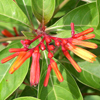Home >>> Landscaping >> Using Native Plants
Using Native Plants
Native plants are those that occur naturally in an area. Native species have evolved over time with the biological and physical factors such as soil, climate, and rainfall specific to their region.
Landscaping your yard with native plants has many benefits
Native plants provide food and shelter for native wildlife.
The great variety of plant species for all conditions carries a high
habitat value. For a list of wildlife-friendly native plants, check
out Native
Plants for Backyard Florida Habitats.
Check out the University of Florida’s Wildlife Extension for complete
information on Landscaping
for Wildlife.
Native plants help to restore regional landscapes.
They are the best species adapted to local conditions that thrive with
the least care and create a sense of place.
“Wherever I go in America, I like it when the land speaks its own language in its own regional accent.” Ladybird Johnson- Wildflowers Across America, 1993
Using native plants promotes wise stewardship of the land and conservation for our natural areas. Native species are members of a community of plants, animals, and microorganisms that keep each other in check and won’t harm natural areas.
Follow these principles when landscaping with natives:
Right Plant, Right Place—assess your local site conditions and select compatible plants whose ultimate size and shape fit your needs.
Use a Diversity of Plants—using a variety of plants provides a more diverse wildlife habitat and more seasonal interest, and pest and disease damage is less noticeable.
Plant sites in layers—a multi-layered approach
to your lawn provides more home cooling ability and cover for wildlife
that utilize plants in different ways.
Native plant species that attract wildlife: |
|||
 |
Sweetgum good for seeds |
|
Live Oak good for mast |
 |
Wax Myrtle good for berries |
 |
Beautyberry good for berries |
 |
Firebush good for nectar and berries |
 |
Lanceleaf Coreopsis good for nectar |
|
Cabbage Palm good for fruit |
|
Longleaf Pine good for structure |




